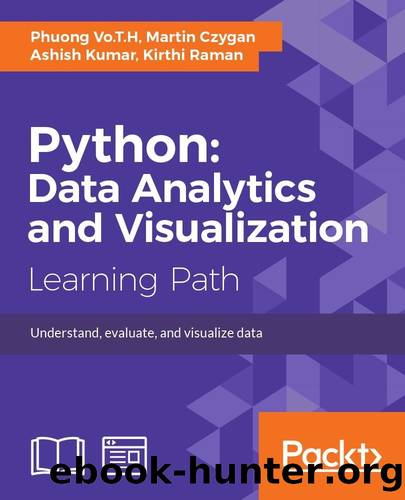Python: Data Analytics and Visualization by Vo.T.H Phuong & Czygan Martin & Kumar Ashish & Raman Kirthi

Author:Vo.T.H, Phuong & Czygan, Martin & Kumar, Ashish & Raman, Kirthi [Vo.T.H, Phuong]
Language: eng
Format: epub
Publisher: Packt Publishing
Published: 2017-03-30T17:00:00+00:00
The goal of this algorithm is to attain a configuration of cluster centers and cluster observation so that the overall J squared error function or J-score is minimized:
Here, c=number of clusters, ci=number of points in the cluster, and Vi=centroid of the ith cluster.
The J squared error function can be understood as the sum of the squared distance of points from their respective cluster centroids. A smaller value of J squared function implies tightly packed and homogeneous clusters. This also implies that most of the points have been placed in the right clusters.
Let us try the k-means clustering algorithm for clustering some random numbers between 0 and 1. The Python library and Scipy have some inbuilt methods to perform the algorithm and return a list defining which observation belongs to which cluster:
Define a set of observations consisting of random numbers ranging from 0 to 1. In this case, we have defined an observation set of 30x3:Import numpy as np obs=np.random.random(90).reshape(30,3) obs
Download
This site does not store any files on its server. We only index and link to content provided by other sites. Please contact the content providers to delete copyright contents if any and email us, we'll remove relevant links or contents immediately.
Hello! Python by Anthony Briggs(10198)
The Mikado Method by Ola Ellnestam Daniel Brolund(10106)
OCA Java SE 8 Programmer I Certification Guide by Mala Gupta(10043)
Algorithms of the Intelligent Web by Haralambos Marmanis;Dmitry Babenko(8588)
Sass and Compass in Action by Wynn Netherland Nathan Weizenbaum Chris Eppstein Brandon Mathis(7969)
Grails in Action by Glen Smith Peter Ledbrook(7942)
Test-Driven iOS Development with Swift 4 by Dominik Hauser(7900)
The Well-Grounded Java Developer by Benjamin J. Evans Martijn Verburg(7841)
Windows APT Warfare by Sheng-Hao Ma(7664)
Layered Design for Ruby on Rails Applications by Vladimir Dementyev(7393)
Blueprints Visual Scripting for Unreal Engine 5 - Third Edition by Marcos Romero & Brenden Sewell(7293)
Secrets of the JavaScript Ninja by John Resig Bear Bibeault(6739)
Kotlin in Action by Dmitry Jemerov(5369)
Solidity Programming Essentials by Ritesh Modi(4469)
Hands-On Full-Stack Web Development with GraphQL and React by Sebastian Grebe(4400)
WordPress Plugin Development Cookbook by Yannick Lefebvre(4279)
Unity 3D Game Development by Anthony Davis & Travis Baptiste & Russell Craig & Ryan Stunkel(4188)
Functional Programming in JavaScript by Mantyla Dan(4170)
The Ultimate iOS Interview Playbook by Avi Tsadok(4162)
